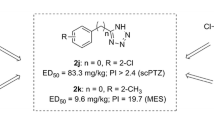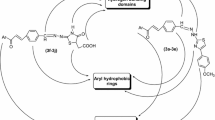Abstract
This study was designed to synthesis of substituted 5-(3-chloro-2-oxo-4-phenylazetidin-1-ylamino)pyrimidine-2,4,6(1H,3H,5H)-triones followed by evaluation against pentylenetetrazole-(PTZ) induced convulsant in mice. The titled compounds were confirmed by IR and 1H-NMR spectral techniques. Pre-treatment of compound 4c showed significant anticonvulsant activity at 40 mg/kg which was comparable to that of PTZ and sodium valproate pre-treated groups. The results show the importance of barbituric acid derivative (i.e., compound 4c (R = p-OH, m-OCH3) for this anti-convulsant activity. It may be due to its anti-oxidative and neuroprotective potential. Therefore, compound 4c emerged as the most active molecules in the management of convulsive disorder.

Similar content being viewed by others
References
Aldarmaa J, Liu Z, Long J, Mo X, Ma J, Liu J (2010) Anti-convulsant effect and mechanism of Astragalus mongholicus extract in vitro and in vivo: protection against oxidative damage and mitochondrial dysfunction. J Neurochem Res 35:33–41
An HS, Cho BM, Kang JH, Kim MK, Oh SM, Park SH (2010) Efficacy of low dose barbiturate coma therapy for the patients with intractable intracranial hypertension using the bispectral index monitoring. J Korean Neurosurg Soc 47:252–257
Bashkatova V, Narkevich V, Vitskova G, Vanin A (2004) The influence of anticonvulsant and antioxidant drugs on nitric oxide level and lipid peroxidation in the rat brain during penthylenetetrazole-induced epileptiform model seizures. Prog Neuropsychopharmacol Biol Psychiatry 27:487–492
Blom S, Heijbel J, Bergfors PG (1978) Incidence of epilepsy in children: a follow-up study three years after the first seizure. Epilepsia 19:343–350
Chang YJ, Ryu SJ, Chen JR, Hu HH, Yip PK, Chiu TF (2008) Consensus group of Taiwan stroke society. Guidelines for the general management of patients with acute ischemic stroke. Acta Neurol Taiwan 17:275–294
Cordato DJ, Herkes GK, Mather LE, Morgan MK (2003) Barbiturates for acute neurological and neurosurgical emergencies—do they still have a role? J Clin Neurosci 10:283–288
Cortas NK, Wakid NW (1990) Determination of inorganic nitrate in serum and urine by a kinetic cadmium-reduction method. Clin Chem 36:1440–1443
DeDeyne CS (2010) Therapeutic hypothermia and traumatic brain injury. Curr Opin Anaesthesiol 23:258–262
Ellman GL (1959) Tissue sulfhydryl groups. Arch Biochem Biophys 82:70–77
English J, Davis B (2010) Case report: death associated with stroke following intracarotid amobarbital testing. Epilepsy Behav 17:283–284
Ghahremanzadeh R, Fereshtehnejad F, Bazgir A (2010) Chromeno[2,3-d]pyrimidine-triones synthesis by a three-component coupling reaction. Chem Pharm Bull 58:516–520
Greenwood RS (2000) Adverse effects of antiepileptic drugs. Epilepsia 41:S42–S52
Haerer AF, Anderson DW, Schoenberg BS (1986) Prevalence and clinical features of epilepsy in a biracial United States population. Epilepsia 27:66–75
Hashizume H, Takigawa M, Tokura Y (2002) Characterization of drug-specific T cells in phenobarbital-induced eruption. J Immunol 168:5359–5368
Kidwai M, Thakur R, Mohan R (2005) Eco friendly synthesis of novel antifungal (thio) barbituric acid derivatives. Acta Chim Slov 52:88–92
Kim GH, Lee HW, Park H, Lee SK, Lee SA, Kim YI, Song HK, Shin DJ, Hong SB (2010) Seizure exacerbation and hormonal cycles in women with epilepsy. Epilepsy Res 90:214–220
Kossoff EH, Andermann F (2010) Migraine and epilepsy. Semin Pediatr Neurol 17:117–122
Kramer G (2001) Epilepsy in the elderly: some clinical and pharmacotherapeutic aspects. Epilepsia 42:55–59
Llompart-Pou JA, Perez-Bárcena J, Raurich JM, Burguera B, Ayestaran JI, Abadal JM, Homar J, Ibanez J (2007) Effect of barbiturate coma on adrenal response in patients with traumatic brain injury. J Endocrinol Invest 30:393–398
Lorke D (1983) A new approach to acute toxicity testing. Arch Toxicol 54:275–287
Lowry OH, Rosenbrough NJ, Farr AL, Randall RJ (1951) Protein measurement with folin phenol reagent. J Biol Chem 193:265–275
Mamishi S, Fattahi F, Pourpak Z, Aghaee FM, Moinfar Z, Mohammadi M, Ashrafi M, Moin M (2009) Severe cutaneous reactions caused by barbiturates in seven Iranian children. Int J Dermatol 48:1254–1261
Molina DK, McCutcheon JR, Rulon JJ (2009) Head injuries, pentobarbital and the determination of death. Am J Forensic Med Pathol 30:75–77
Neil MJ, Dale MC (2009) Hypokalaemia with severe rebound hyperkalaemia after therapeutic barbiturate coma. Anesth Analg 108:1867–1868
Ohkawa H, Ohishi N, Yagi K (1979) Assay for lipid peroxides in animal tissues by thiobarbituric acid reaction. Anal Biochem 95:351–358
Oliveira MS, Furian AF, Royes LFF, Fighera MR, Myskiw JC, Fiorenza NG, Mello CF (2004) Ascorbate modulates pentylenetetrazol-induced convulsions biphasically. Neuroscience 128:721–728
Shaik IH, Mehvar R (2010) Cytochrome P450 induction by phenobarbital exacerbates warm hepatic ischemia-reperfusion injury in rat livers. Free Radic Res 44:441–453
Skinner HI, Dubon-Murcia SA, Thompson AR, Medina MT, Edwards JC, Nicholas JS, Holden KR (2010) Adult convulsive status epilepticus in the developing country of Honduras. Seizure 19:363–367
Stover JF, Stocker R (1998) Barbiturate coma may promote reversible bone marrow suppression in patients with severe isolated traumatic brain injury. Eur J Clin Pharmacol 54:529–534
Thuong M, Matta B, Menon D (2008) Sedation and analgesia assessment tools in ICU patients. Ann Fr Anesth Reanim 27:581–595
Tuchman R, Cuccaro M, Alessandri M (2010) Autism and epilepsy: historical perspective. Brain Dev 32:709–718
Uciechowska U, Schemies J, Neugebauer RC, Huda EM, Schmitt ML, Meier R, Verdin E, Jung M, Sippl W (2008) Thiobarbiturates as sirtuin inhibitors: virtual screening, free-energy calculations and biological testing. Chem Med Chem 3:1965–1976
Uma Devi P, Pillai KK, Vohora D (2006) Modulation of pentylenetetrazole-induced seizures and oxidative stress parameters by sodium valproate in the absence and presence of N-acetylcysteine. Fundam Clin Pharmacol 20:247–253
Wakamatsu T, Tanaka T, Oda S, Nishi K, Harada H, Daijo H, Takabuchi S, Kai S, Fukuda K, Hirota K (2009) The intravenous anesthetics barbiturates inhibit hypoxia-inducible factor 1 activation. Eur J Pharmacol 617:17–22
Yan LJ, Traber MG, Packer L (1995) Spectrophotometric method for determination of carbonyls in oxidatively modified apolipoprotein B of human low-density lipoproteins. Anal Biochem 228:349–351
Yan Q, Cao R, Yi W, Chen Z, Wen H, Ma L, Song H (2009) Inhibitory effects of 5-benzylidene barbiturate derivatives on mushroom tyrosinase and their antibacterial activities. Eur J Med Chem 44:4235–4243
Acknowledgment
Thanks to Dr. A.C. Rana and all faculty members of Rayat Institute of Pharmacy for their encouragement and support. We are also grateful to Rayat & Bahra Educational and Research Trust for their unconditional help to carry out this project.
Conflict of interest
There was no conflict of interest in this study.
Author information
Authors and Affiliations
Corresponding author
Rights and permissions
About this article
Cite this article
Puri, K.D.S., Sood, S. & Muthuraman, A. Synthesis and evaluation of substituted 5-(3-chloro-2-oxo-4-phenylazetidin-1-ylamino)pyrimidine-2,4,6(1H,3H,5H)-triones against pentylenetetrazole-induced convulsant in mice. Med Chem Res 21, 2300–2306 (2012). https://doi.org/10.1007/s00044-011-9760-8
Received:
Accepted:
Published:
Issue Date:
DOI: https://doi.org/10.1007/s00044-011-9760-8




